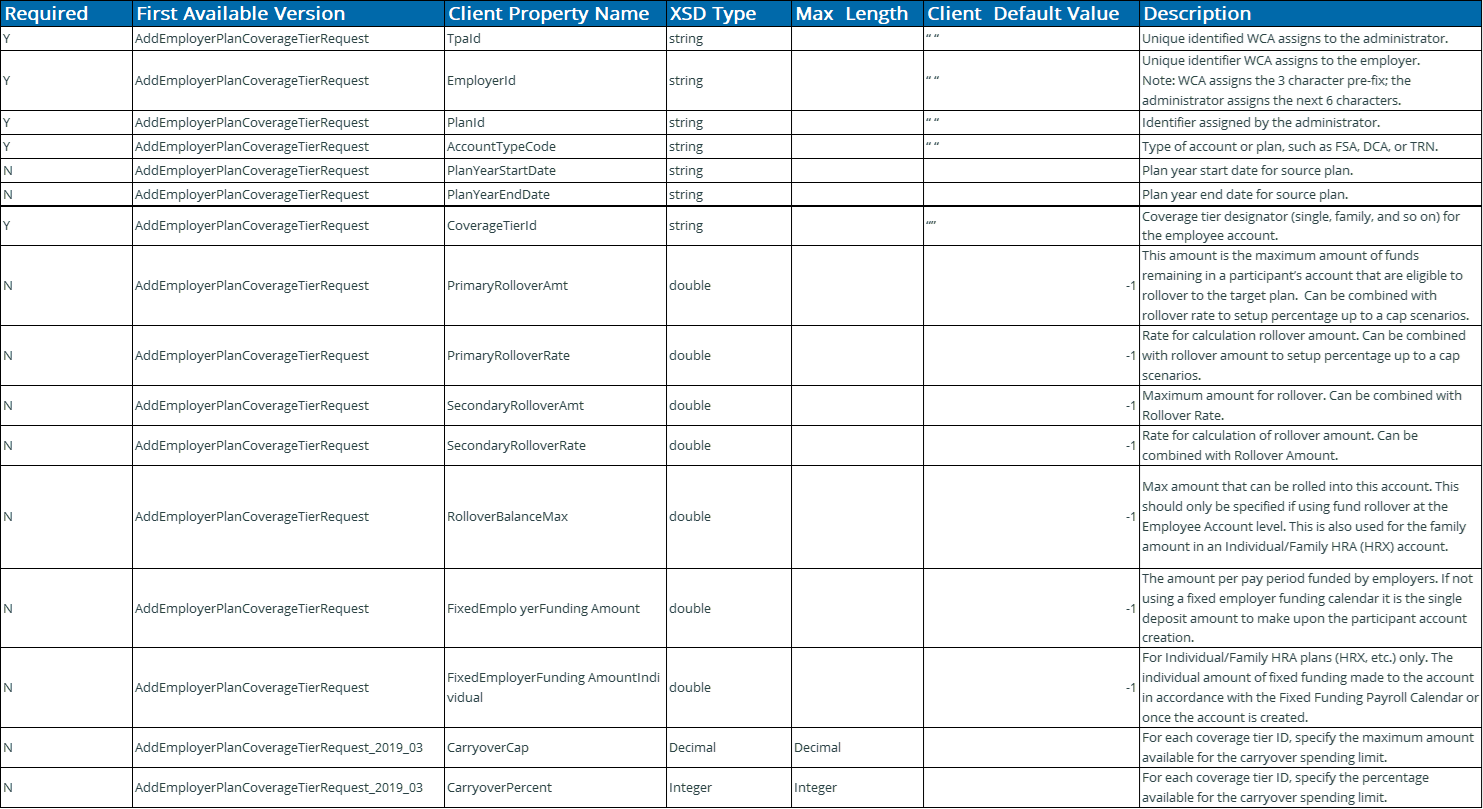
Employer Plan Coverage Tier API | Administrative - SOAP
The employer plan coverage tier service provides clients plan related functionalities such as reading, adding, updating, and deleting coverage tier information from plans.
Service web methods
The following operations are supported.
AddEmployerPlanCoverageTier - This method is used to add coverage tier information to an existing employer plan that has the associated coverage tier type.
DeleteEmployerPlanCoverageTier - This method is used to delete an existing coverage tier from an existing employer’s plan.
GetEmployerPlanCoverageTiers - This method is used to retrieve coverage tier information for an existing employer’s plan.
UpdateEmployerPlanCoverageTier - This method is used to update coverage tier information in an existing employer’s plan that has the associated coverage tier.
Service assumptions/business rules
The EmployerPlanCoverageTier service makes the following assumptions and enforces the following business rules:
Clients shall conform to the WS-I specifications unless otherwise agreed upon by Alegeus and the administrator.
Clients shall format SOAP messages in a document/literal format over HTTPS.
Clients shall have a valid user ID and password.
Clients shall have a valid session ID after being authenticated by the system. The session ID needs to be passed in the proper manner as described in the account manager service guide.
If the administrator uses the same user ID and password for all of their clients, the administrator is responsible for managing the security of the data.
Clients should validate data before submitting a request to this service. This facilitates better performance and accurate processing on both systems.
Clients shall not attempt to use this service for batch processing of large amounts of data. The service is designed for synchronous calls that send or retrieve small chunks of data. If batch processing is required, then the EDI process should be used.
If any method fails, the service returns a SOAP fault describing the problem.
AddEmployerPlanCoverageTier
This method provides the functionality to add coverage tier information to existing employer plans that have the associated coverage tier type.
History
The AddEmployerPlanCoverageTier methods are listed below:
Request messages
AddEmployerPlanCoverageTierRequest
AddEmployerPlanCoverageTierRequest_2019_03
Response messages
AddEmployerPlanCoverageTierResponse
AddEmployerPlanCoverageTier request/response messages
The AddEmployerPlanCoverageTier method requires the following request and response messages (input and output data).
The table below includes the following request messages:
AddEmployerPlanCoverageTierRequest

Response message: Empty message.
Example of AddEmployerPlanCoverageTier SOAP request message
<?xml version="1.0" encoding="utf-8"?>
<soap:Envelope xmlns:xsi="http://www.w3.org/2001/XMLSchema-instance" xmlns:xsd="http://www.w3.org/2001/XMLSchema" xmlns:soap="http://schemas.xmlsoap.org/soap/envelope/">
<soap:Header>
<MBISessionHeader xmlns="http://www.medibank.com/MBIWebServices/SoapHeader/">
<MBISessionID>string</MBISessionID>
</MBISessionHeader>
</soap:Header>
<soap:Body>
<AddEmployerPlanCoverageTier xmlns="http://www.medibank.com/MBIWebServices/Employer/Messages/EmployerPlan/Request/2008/07/">
<request>
<TpaId>string</TpaId>
<EmployerId>string</EmployerId>
<PlanId>string</PlanId>
<AccountTypeCode>string</AccountTypeCode>
<PlanYearStartDate>string</PlanYearStartDate>
<PlanYearEndDate>string</PlanYearEndDate>
<CoverageTierId>string</CoverageTierId>
<PrimaryRolloverAmt>decimal</PrimaryRolloverAmt>
<PrimaryRolloverRate>decimal</PrimaryRolloverRate>
<SecondaryRolloverAmt>decimal</SecondaryRolloverAmt>
<SecondaryRolloverRate>decimal</SecondaryRolloverRate>
<RolloverBalanceMax>decimal</RolloverBalanceMax>
<FixedEmployerFundingAmount>double</FixedEmployerFundingAmount>
<FixedEmployerFundingAmountIndividual>double</FixedEmployerFundingAmountIndividual>
</request>
</AddEmployerPlanCoverageTier>
</soap:Body>
</soap:Envelope>
Example of AddEmployerPlanCoverageTier SOAP response message
<?xml version="1.0" encoding="utf-8"?>
<soap:Envelope xmlns:xsi="http://www.w3.org/2001/XMLSchema-instance" xmlns:xsd="http://www.w3.org/2001/XMLSchema" xmlns:soap="http://schemas.xmlsoap.org/soap/envelope/">
<soap:Header>
<MBIMessageIdHeader xmlns="http://www.medibank.com/MBIWebServices/SoapHeader/">
<MessageId>string</MessageId>
</MBIMessageIdHeader>
</soap:Header>
<soap:Body>
<AddEmployerPlanCoverageTierResponse xmlns="http://www.medibank.com/MBIWebServices/Employer/Messages/EmployerPlan/Response/2008/07/">
<AddEmployerPlanCoverageTierResult />
</AddEmployerPlanCoverageTierResponse>
</soap:Body>
</soap:Envelope>
Example client code
The following is an example of the client code (using a .NET proxy class for accessing the service) used when calling the AddEmployerPlanCoverageTier web method.
try
{
// create new SOAP header for the user’s current session id
localhost.MBISessionHeader sh = new localhost.MBISessionHeader();
// create the proxy object for the service
localhost.EmployerPlanCoverageTierService proxy = new localhost.EmployerPlanCoverageTierService(); // create a new request object for the method’s parameters localhost.AddEmployerPlanCoverageTier request = new localhost.AddEmployerPlanCoverageTier();
// set the parameters for the web method call request.TpaId = "T00021";
request.EmployerId = “MYEMPLR”; request.PlanId = “FSA2009”;
request.AccountTypeCode = “FSA”;
request.CoverageTierId = “TIER1”;
// Add the session SOAP header so that the service knows who we are.
// Note that we stored the session ID in a member variable after
// logged in to the system for future web method calls.
sh.MBISessionID = _sessionID; proxy.MBISessionHeaderValue = sh;
// Call the web method.
proxy. AddEmployerPlanCoverageTier(request);
MessageBox.Show("Finished");
}
catch(SoapException se)
{
// perform needed operations
}
catch(Exception ex)
{
// perform needed operations
}
DeleteEmployerPlanCoverageTier
This method provides the functionality to delete existing coverage tier information from an existing plan.
History
The DeleteEmployerPlanCoverageTier methods are listed below:
Request messages
DeleteEmployerPlanCoverageTierRequest
Response messages
DeleteEmployerPlanCoverageTierResponse
DeleteEmployerPlanCoverageTier request/response messages
The DeleteEmployerPlanCoverageTier method requires the following request and response messages (input and output data).
The table below includes the following request messages:
DeleteEmployerPlanCoverageTierRequest

Response message: Empty message.
Example of DeleteEmployerPlanCoverageTier SOAP request message
<?xml version="1.0" encoding="utf-8"?>
<soap:Envelope xmlns:xsi="http://www.w3.org/2001/XMLSchema-instance" xmlns:xsd="http://www.w3.org/2001/XMLSchema" xmlns:soap="http://schemas.xmlsoap.org/soap/envelope/">
<soap:Header>
<MBISessionHeader xmlns="http://www.medibank.com/MBIWebServices/SoapHeader/">
<MBISessionID>string</MBISessionID>
</MBISessionHeader>
</soap:Header>
<soap:Body>
<DeleteEmployerPlanCoverageTierRequest xmlns="http://www.medibank.com/MBIWebServices/Employer/Messages/EmployerPlanCoverageTier/Request/2008/07">
<request>
<TpaId>string</TpaId>
<EmployerId>string</EmployerId>
<PlanId>string</PlanId>
<AccountTypeCode>string</AccountTypeCode>
<PlanYearStartDate>string</PlanYearStartDate>
<PlanYearEndDate>string</PlanYearEndDate>
<CoverageTierId>string</CoverageTierId>
</request>
</DeleteEmployerPlanCoverageTierRequest>
</soap:Body>
</soap:Envelope>
Example of DeleteEmployerPlanCoverageTier SOAP response message
<?xml version="1.0" encoding="utf-8"?>
<soap:Envelope xmlns:xsi="http://www.w3.org/2001/XMLSchema-instance" xmlns:xsd="http://www.w3.org/2001/XMLSchema" xmlns:soap="http://schemas.xmlsoap.org/soap/envelope/">
<soap:Header>
<MBIMessageIdHeader xmlns="http://www.medibank.com/MBIWebServices/SoapHeader/">
<MessageId>string</MessageId>
</MBIMessageIdHeader>
</soap:Header>
<soap:Body>
<DeleteEmployerPlanCoverageTierResponse
xmlns="http://www.medibank.com/MBIWebServices/Employer/Messages/EmployerPlanCoverageTier/Response/2008/07">
<DeleteEmployerPlanCoverageTierResult />
</DeleteEmployerPlanCoverageTierResponse>
</soap:Body>
</soap:Envelope>
Example client code
The following is an example of the client code (using a .NET proxy class for accessing the service) used when calling the DeleteEmployerPlanCoverageTier web method.
try
{
// create new SOAP header for the user’s current session id localhost.MBISessionHeader sh = new localhost.MBISessionHeader();
// create the proxy object for the service
localhost.EmployerPlanCoverageTierService proxy = new localhost.EmployerPlanCoverageTierService();
// create a new request object for the method’s parameters localhost.DeleteEmployerPlanCoverageTier request = new localhost.DeleteEmployerPlanCoverageTier();
// set the parameters for the web method call request.TpaId = "T00021";
request.EmployerId = “MYEMPLR”; request.PlanId = “FSA2009”;
request.AccountTypeCode = “FSA”;
request.CoverageTierId = “TIER1”;
// Add the session SOAP header so that the service knows who we are.
// Note that we stored the session ID in a member variable after
// logged in to the system for future web method calls.
sh.MBISessionID = _sessionID; proxy.MBISessionHeaderValue = sh;
// Call the web method.
proxy. DeleteEmployerPlanCoverageTier(request);
MessageBox.Show("Finished");
}
catch(SoapException se)
{
// perform needed operations
}
catch(Exception ex)
{
// perform needed operations
}
GetEmployerPlanCoverageTiers
This method provides the functionality to retrieve coverage tier information for an existing employer’s plan.
History
The GetEmployerPlanCoverageTiers methods are listed below:
Request messages
GetEmployerPlanCoverageTiersRequest
Response messages
GetEmployerPlanCoverageTiersResponse
GetEmployerPlanCoverageTierResponse_2019_03
GetEmployerPlanCoverageTiers request/response messages
The GetEmployerPlanCoverageTiers method requires the following request and response messages (input and output data).
The table below includes the following request messages:
GetEmployePlanCoverageTiersRequest

The table below includes the following response messages:
GetEmployerPlanCoverageTiersResponse

Example of GetEmployerPlanCoverageTiers SOAP request message
<?xml version="1.0" encoding="utf-8"?>
<soap:Envelope xmlns:xsi="http://www.w3.org/2001/XMLSchema-instance" xmlns:xsd="http://www.w3.org/2001/XMLSchema" xmlns:soap="http://schemas.xmlsoap.org/soap/envelope/">
<soap:Header>
<MBISessionHeader xmlns="http://www.medibank.com/MBIWebServices/SoapHeader/">
<MBISessionID>string</MBISessionID>
</MBISessionHeader>
</soap:Header>
<soap:Body>
<GetEmployerPlanCoverageTiersRequest xmlns="http://www.medibank.com/MBIWebServices/Employer/Messages/EmployerPlanCoverageTier/Request/2008/07">
<request>
<TpaId>string</TpaId>
<EmployerId>string</EmployerId>
<PlanId>string</PlanId>
<AccountTypeCode>string</AccountTypeCode>
<PlanYearStartDate>string</PlanYearStartDate>
<PlanYearEndDate>string</PlanYearEndDate>
</request>
</GetEmployerPlanCoverageTiersRequest>
</soap:Body>
</soap:Envelope>
Example of GetEmployerPlanCoverageTiers SOAP response message
<?xml version="1.0" encoding="utf-8"?>
<soap:Envelope xmlns:xsi="http://www.w3.org/2001/XMLSchema-instance" xmlns:xsd="http://www.w3.org/2001/XMLSchema" xmlns:soap="http://schemas.xmlsoap.org/soap/envelope/">
<soap:Header>
<MBIMessageIdHeader xmlns="http://www.medibank.com/MBIWebServices/SoapHeader/">
<MessageId>string</MessageId>
</MBIMessageIdHeader>
</soap:Header>
<soap:Body>
<GetEmployerPlanCoverageTiersResponse xmlns="http://www.medibank.com/MBIWebServices/Employer/Messages/EmployerPlanCoverageTier/Response/2008/07"> <GetEmployerPlanCoverageTiersResult>
<GetEmployerPlanCoverageTiersResponse>
<TpaId>string</TpaId>
<EmployerId>string</EmployerId>
<PlanId>string</PlanId>
<AccountTypeCode>string</AccountTypeCode>
<PlanYearStartDate>string</PlanYearStartDate>
<PlanYearEndDate>string</PlanYearEndDate>
<CoverageTierId>string</CoverageTierId>
<PrimaryRolloverAmt>decimal</PrimaryRolloverAmt>
<PrimaryRolloverRate>decimal</PrimaryRolloverRate>
<SecondaryRolloverAmt>decimal</SecondaryRolloverAmt>
<SecondaryRolloverRate>decimal</SecondaryRolloverRate>
<RolloverBalanceMax>decimal</RolloverBalanceMax>
<FixedEmployerFundingAmount>double</FixedEmployerFundingAmount>
<FixedEmployerFundingAmountIndividual>double</FixedEmployerFundingAmountIndividual>
</GetEmployerPlanCoverageTiersResponse>
<GetEmployerPlanCoverageTiersResponse>
<TpaId>string</TpaId>
<EmployerId>string</EmployerId>
<PlanId>string</PlanId>
<AccountTypeCode>string</AccountTypeCode>
<PlanYearStartDate>string</PlanYearStartDate>
<PlanYearEndDate>string</PlanYearEndDate>
<CoverageTierId>string</CoverageTierId>
<PrimaryRolloverAmt>decimal</PrimaryRolloverAmt>
<PrimaryRolloverRate>decimal</PrimaryRolloverRate>
<SecondaryRolloverAmt>decimal</SecondaryRolloverAmt>
<SecondaryRolloverRate>decimal</SecondaryRolloverRate>
<RolloverBalanceMax>decimal</RolloverBalanceMax>
<FixedEmployerFundingAmount>double</FixedEmployerFundingAmount>
<FixedEmployerFundingAmountIndividual>double</FixedEmployerFundingAmountIndividual>
</GetEmployerPlanCoverageTiersResponse>
</GetEmployerPlanCoverageTiersResult>
</GetEmployerPlanCoverageTiersResponse>
</soap:Body>
</soap:Envelope>
Example client code
The following is an example of the client code (using a .NET proxy class for accessing the service) used when calling the GetEmployerPlanCoverageTiers web method.
try
{
// create new SOAP header for the user’s current session id
localhost.MBISessionHeader sh = new localhost.MBISessionHeader();
// create the proxy object for the service
localhost.EmployerPlanCoverageTierService proxy = new localhost.EmployerPlanCoverageTierService();
// create a new request object for the method’s parameters
localhost.GetEmployerPlanCoverageTiers request = new localhost.GetEmployerPlanCoverageTiers();
localhost.GetEmployerPlanCoverageTiers response;
// set the parameters for the web method call request.TpaId = "T00021";
request.EmployerId = “MYEMPLR”; request.PlanId = “FSA2009”;
request.AccountTypeCode = “FSA”;
// Add the session SOAP header so that the service knows who we are.
// Note that we stored the session ID in a member variable after
// logged in to the system for future web method calls.
sh.MBISessionID = _sessionID; proxy.MBISessionHeaderValue = sh;
// Call the web method. response = proxy. GetEmployerPlanCoverageTiers(request); if(response != null)
{
for(int x=0; x<response.length; x++)
{
//add code to read fields
}
}
MessageBox.Show("Finished");
}
catch(SoapException se)
{
// perform needed operations
}
catch(Exception ex)
{
// perform needed operations
}
UpdateEmployerPlanCoverageTier
This method provides the functionality to update existing coverage tier information for an existing employer’s plan.
History
The UpdateEmployerPlanCoverageTier methods are listed below:
Request messages
UpdateEmployerPlanCoverageTierRequest
UpdateEmployerPlanCoverageTierRequest_2019_03
Response messages
UpdateEmployerPlanCoverageTierResponse
UpdateEmployerPlanCoverageTier request/response messages
The UpdateEmployerPlanCoverageTier method requires the following request and response messages (input and output data).
The table below includes the following request messages:
UpdateEmployerPlanCoverageTierRequest

Example of UpdateEmployerPlanCoverageTier SOAP request message
<?xml version="1.0" encoding="utf-8"?>
<soap:Envelope xmlns:xsi="http://www.w3.org/2001/XMLSchema-instance" xmlns:xsd="http://www.w3.org/2001/XMLSchema" xmlns:soap="http://schemas.xmlsoap.org/soap/envelope/">
<soap:Header>
<MBISessionHeader xmlns="http://www.medibank.com/MBIWebServices/SoapHeader/">
<MBISessionID>string</MBISessionID>
</MBISessionHeader>
</soap:Header>
<soap:Body>
<UpdateEmployerPlanCoverageTierRequest xmlns="http://www.medibank.com/MBIWebServices/Employer/Messages/EmployerPlanCoverageTier/Request/2008/07">
<request>
<TpaId>string</TpaId>
<EmployerId>string</EmployerId>
<PlanId>string</PlanId>
<AccountTypeCode>string</AccountTypeCode>
<PlanYearStartDate>string</PlanYearStartDate>
<PlanYearEndDate>string</PlanYearEndDate>
<CoverageTierId>string</CoverageTierId>
<PrimaryRolloverAmt>decimal</PrimaryRolloverAmt>
<PrimaryRolloverRate>decimal</PrimaryRolloverRate>
<SecondaryRolloverAmt>decimal</SecondaryRolloverAmt>
<SecondaryRolloverRate>decimal</SecondaryRolloverRate>
<RolloverBalanceMax>decimal</RolloverBalanceMax>
<FixedEmployerFundingAmount>double</FixedEmployerFundingAmount>
<FixedEmployerFundingAmountIndividual>double</FixedEmployerFundingAmountIndividual> </request>
</UpdateEmployerPlanCoverageTierRequest>
</soap:Body>
</soap:Envelope>
Example of UpdateEmployerPlanCoverageTier SOAP response message
<?xml version="1.0" encoding="utf-8"?>
<soap:Envelope xmlns:xsi="http://www.w3.org/2001/XMLSchema-instance" xmlns:xsd="http://www.w3.org/2001/XMLSchema" xmlns:soap="http://schemas.xmlsoap.org/soap/envelope/">
<soap:Header>
<MBIMessageIdHeader xmlns="http://www.medibank.com/MBIWebServices/SoapHeader/">
<MessageId>string</MessageId>
</MBIMessageIdHeader>
</soap:Header>
<soap:Body>
<UpdateEmployerPlanCoverageTierResponse xmlns="http://www.medibank.com/MBIWebServices/Employer/Messages/EmployerPlan/Response/2008/07/">
<UpdateEmployerPlanCoverageTierResult />
</UpdateEmployerPlanCoverageTierResponse>
</soap:Body>
</soap:Envelope>
Example client code
The following is an example of the client code (using a .NET proxy class for accessing the service) used when calling the UpdateEmployerPlanCoverageTier web method.
try
{
// create new SOAP header for the user’s current session id localhost.MBISessionHeader sh = new localhost.MBISessionHeader();
// create the proxy object for the service
localhost.EmployerPlanCoverageTierService proxy = new localhost.EmployerPlanCoverageTierService();
// create a new request object for the method’s parameters
localhost.UpdateEmployerPlanCoverageTier request = new localhost.UpdateEmployerPlanCoverageTier();
// set the parameters for the web method call request.TpaId = "T00021";
request.EmployerId = “MYEMPLR”;
request.PlanId = “FSA2009”;
request.AccountTypeCode = “FSA”;
request.CoverageTierId = “TIER1”;
// Add the session SOAP header so that the service knows who we are.
// Note that we stored the session ID in a member variable after
// logged in to the system for future web method calls.
sh.MBISessionID = _sessionID; proxy.MBISessionHeaderValue = sh;
// Call the web method.
proxy.UpdateEmployerPlanCoverageTier(request);
MessageBox.Show("Finished");
}
catch(SoapException se)
{
// perform needed operations
}
catch(Exception ex)
{
// perform needed operations
}
Copyright © 2023 Alegeus Technologies, LLC. All rights reserved. Alegeus, Alegeus Technologies, WealthCare, WealthCare Saver are registered trademarks of Alegeus Technologies, LLC